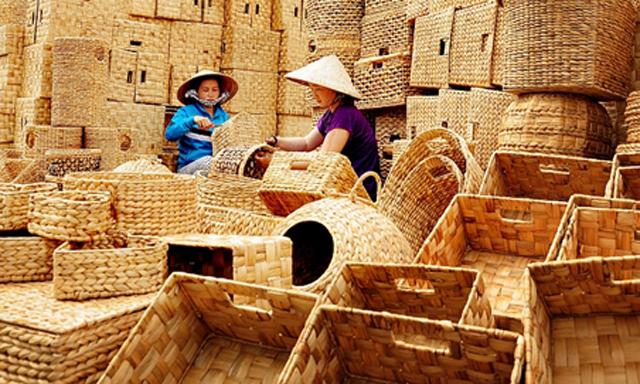
HANOI – The EU is a potential market for Vietnam’s handicraft products, especially ones made of bamboo and rattan, but the export turnover of such products is still low due to a lack of market information and creativity in designs, experts said at a seminar in Hanoi this week.
Little changes in design
According to the Department of Processing and Trade for Agro-Forestry-Fisheries Products and Salt Production, the handicraft sector has a large workforce with around 350,000 laborers. Handicraft products are not only supplied for the domestic market but also for export to 120 countries and territories with an average export turnover of US$200 million in recent years, with exports to EU ranking second.
Usually, each worker will be in charge of a certain stage for the production of each product. In this photo, a craftswoman is polishing a product coated with gold lacquer.
Grinding creates necessary gloss and brightness for lacquer products.
However, the export turnover of US$200 million is too small compared to the world’s handicraft market of some US$12 billion recorded in 2009 and an estimated US$17 billion in 2017.
Speaking at the seminar on handicraft designs and accessing the EU market held in Hanoi, Ta Hoang Linh, deputy director of the Ministry of Industry and Trade’s Trade Promotion Department, said that the designs of Vietnam’s handicraft products were not eye-catching due to few designers and their poor access to new fashions.
With 14 years of experience of exporting handicraft products to EU, director of Lacquer World Co., Ltd Duong Thi Thanh Thuy said that weaknesses of enterprises producing handicraft products were their unwillingness to produce sophisticated products.
“EU is a picky market requiring creative and careful designs. Products exported to EU have to be made of natural materials, safe, useful, recyclable, have competitive prices and friendly to the environment. Besides, products need to be produced in a safe environment and do not use child labor,” Thuy said.
Meanwhile, to be successful in the EU market and achieve annual revenues of US$1-1.5 million, Duc Phong Co., Ltd has sought to enhance the skills, develop a stable product area, seek European designers, and cooperate with universities specializing in designing in developed countries, said director Thai Dai Phong.

EU consumer trends
According to Adam Thow, head of retail and buying at Southbank Center in the UK, a new trend in consuming woodwork and handicraft products in Europe is to use products with rare materials and special designs, which makes buyers feel like such products are specially designed for them.
In addition, European consumers now tend to favor furniture and decoration items featuring other cultures, opening up an opportunity for products from countries in Asia or the Middle East.
In a market where consumers no longer favor products with mass production and now prefer innovative designs, this is a chance for producers to export their products. Therefore, Vietnamese enterprises need to focus on producing products of high quality and useful for daily life, according to Adam Thow.

